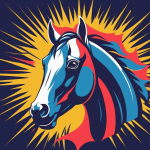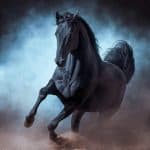The Well-Being of the Horse, an Art of Living
Published on animolemag
“The horse is the noblest conquest of man,” and when the relationship is harmonious, “man becomes the noblest conquest of the horse.” The horse is a naïve and generous animal, and it is thanks to these valuable qualities that riding is possible.
No man could be stronger than a horse and subject him by force without damage. And often when a rider abuses his horse or punishes him a little too much, illnesses appear. It’s all a matter of riding. Horse-riding is the art of riding a horse and not the action of riding a horse.
Balance in the relationship determines the sport future of the pair.
Several aspects must be considered to make this man-horse relationship shine. The feeding aspect is the most delicate one to master insofar as when you want to do it too well you might end up doing it poorly. Horses are greedy and a horse’s digestion is so special that it entails a lot of waste and also produces a lot of toxins through fermentation in the caecum and the large intestine.
The horse must drink first, and then eat hay and food that is adapted to effort and rather richer in fat and protein than in starch. It is appropriate to refer to a veterinarian for horses that have a special and sensitive activity: pathology, growth, gestation, high-level sports events. Then the “physical exercise aspect” must be approached with delicacy, for the horse seldom knows how to spare his energy and stop in time, as he is so much conditioned by his rider.
The metabolic waste produced by physical effort will tend to saturate the muscles in lactic acid, which “stiffens” the horse and moves the rider to exact more from him. In riding, you should leave well-enough alone. Numerous techniques, ranging from a blood take to a muscle palpation make it possible to diagnose overtraining.
The horse must reach performance naturally; he shouldn’t be forced to do it. Sweating, ears pulled backward, stress, decrease in appetite… are signs of overtraining; a horse that is too fat is not getting enough training. The “character aspect” is more difficult to figure out, for it depends on one and the other and on a given moment. This is the aspect that characterizes the oneness of the rider/horse pair. When everything is fine, the pair make one. A temporary disagreement is acceptable as long as both make concessions to make up. Otherwise, a chain reaction will lead to vertebrae pathology in the horse and in the rider.
The horse’s memory makes training possible, and his intelligence makes it possible to solve problems. Thus, in a riding problem it is better to give the horse freedom and supervise him, for open interference by the rider creates an additional problem for the horse and increases stress.
The one who is carrying makes decisions, and the one who is riding supervises. The rider’s work becomes soft and based on persuasion instead of creating a trauma. The notion of domination vanishes and respect sets in.
Conclusion: Currrent veterinary medicine makes it possible to act before problems set in thanks to osteopathy and acupuncture by detecting how fragile the horse and the rider are. When bounds are broken veterinary medicine knows how to treat the horse with injections or surgery. Then a new agreement is to be reached between the rider and his/her horse. The general principle defining the well-being of the horse is “balance.”
Special thanks to Mr. Salah Nasser and Mr. Stephen Poulain for allowing the publication of Tristram Boy and Saint Merry photos.





Comments by Auteur